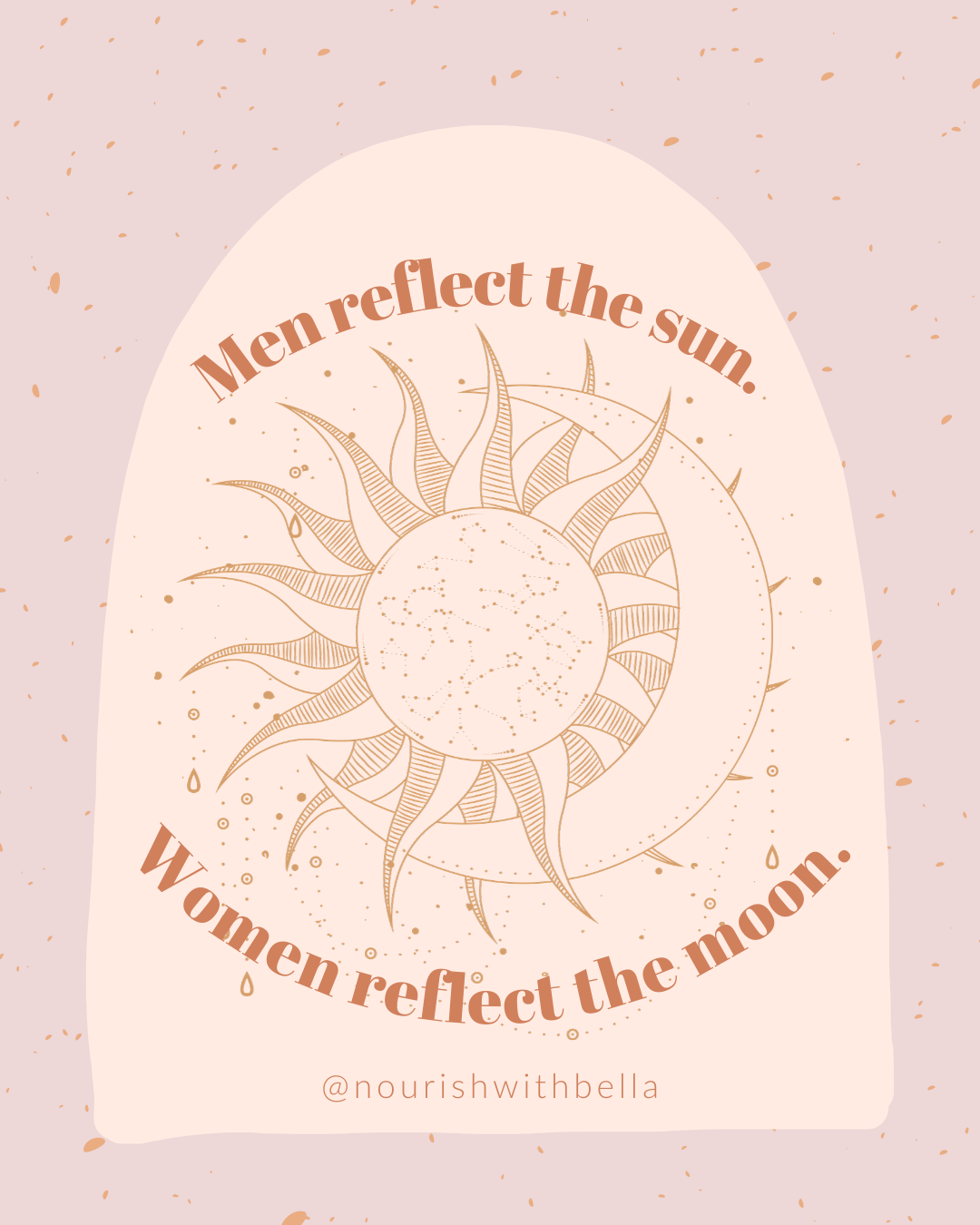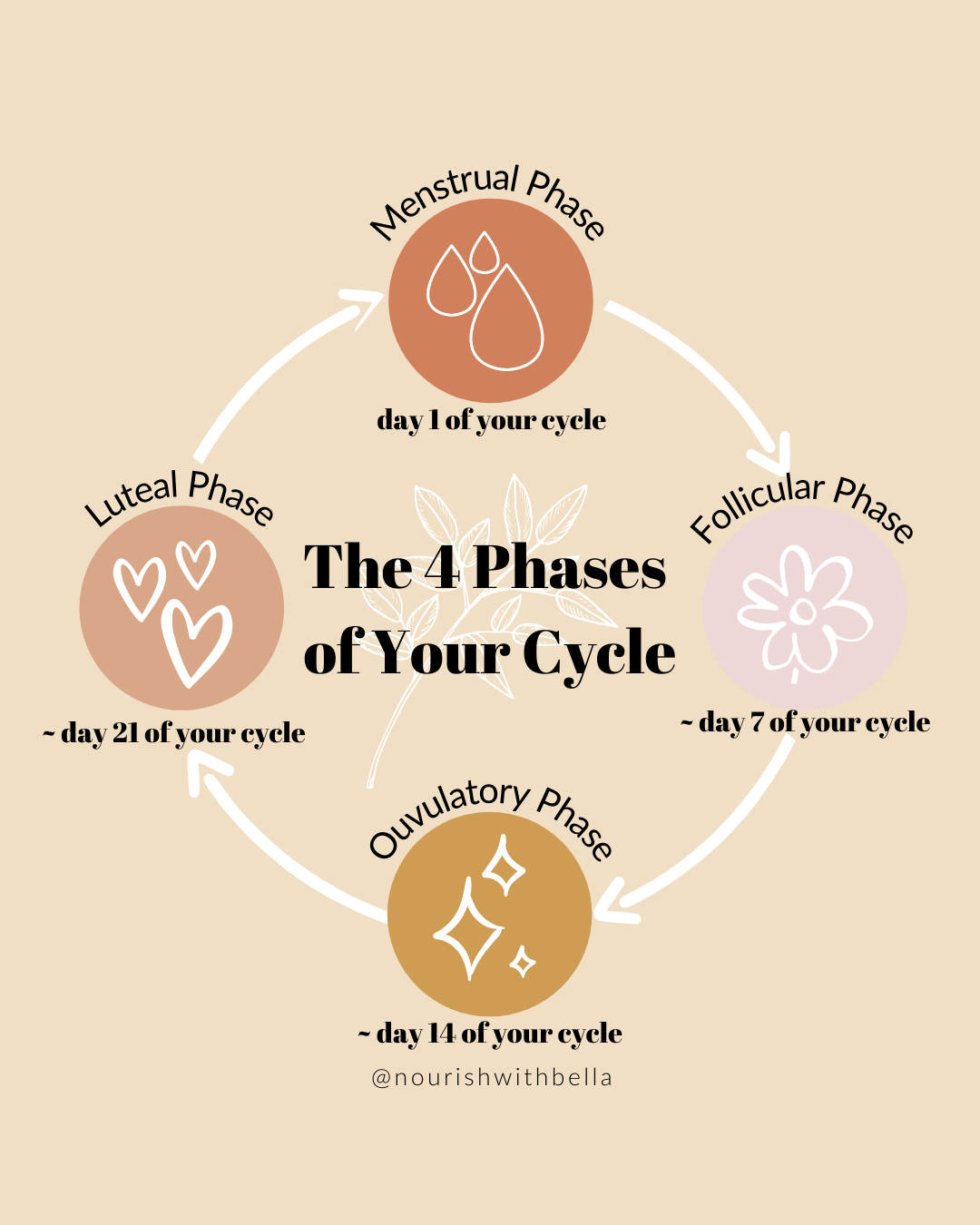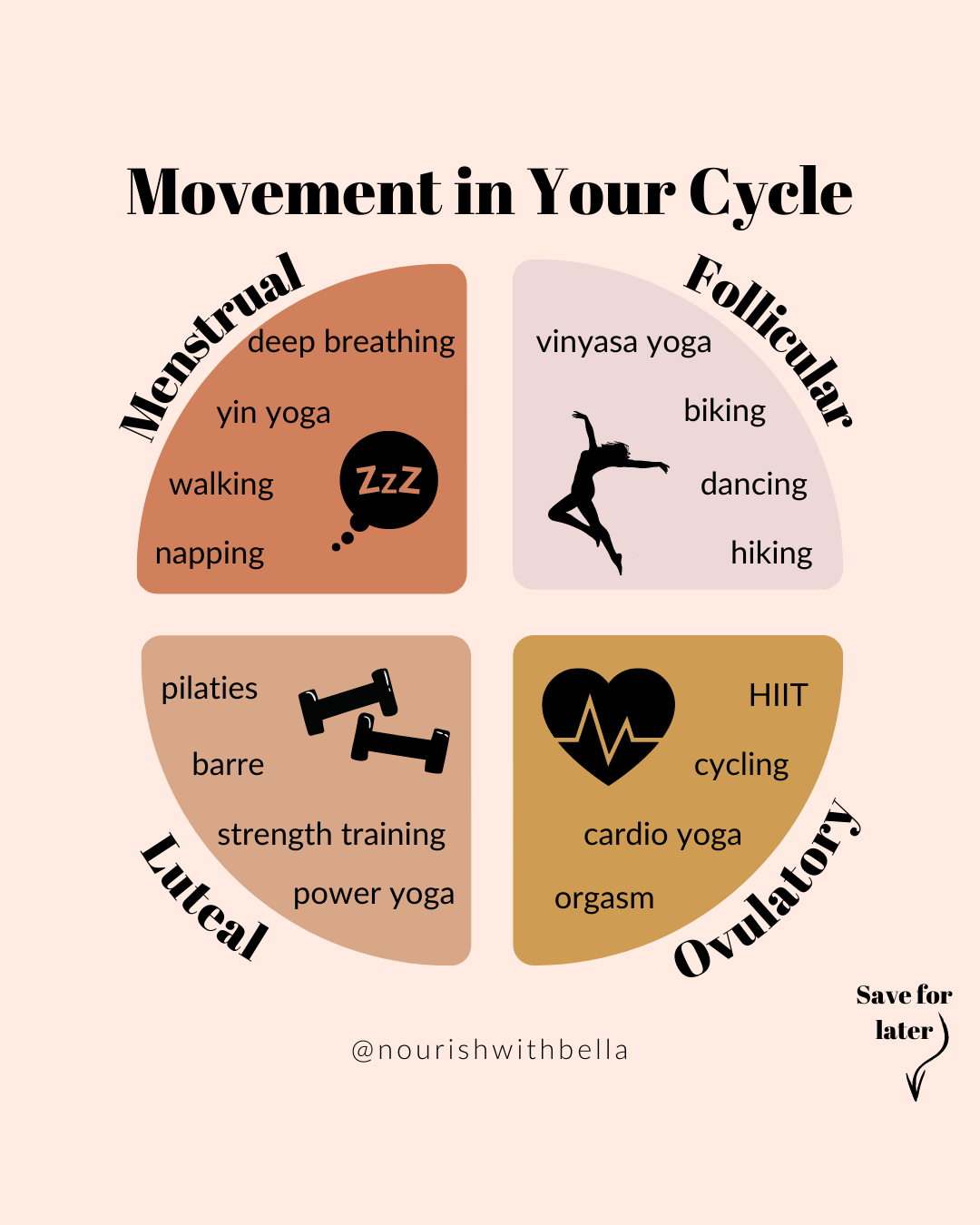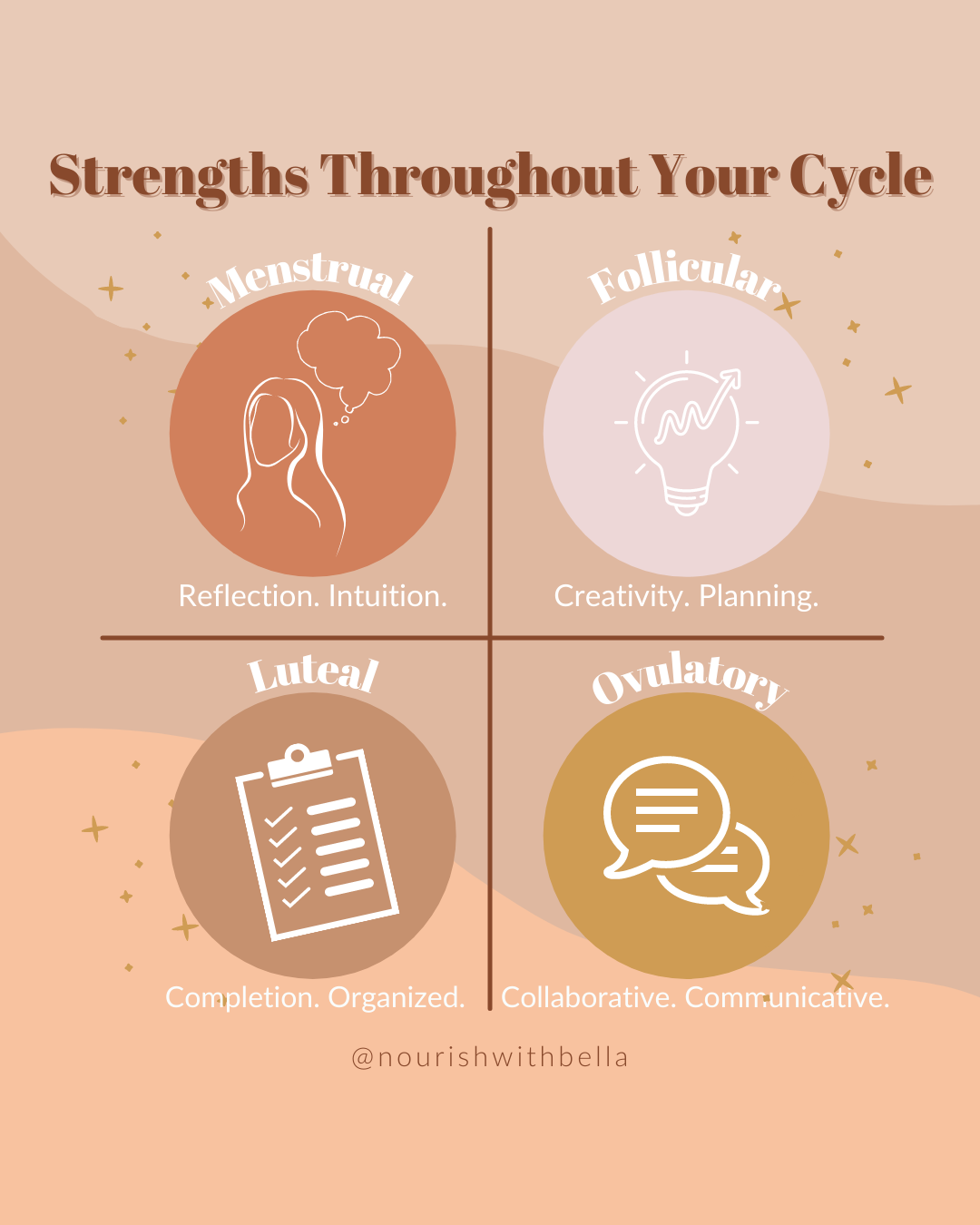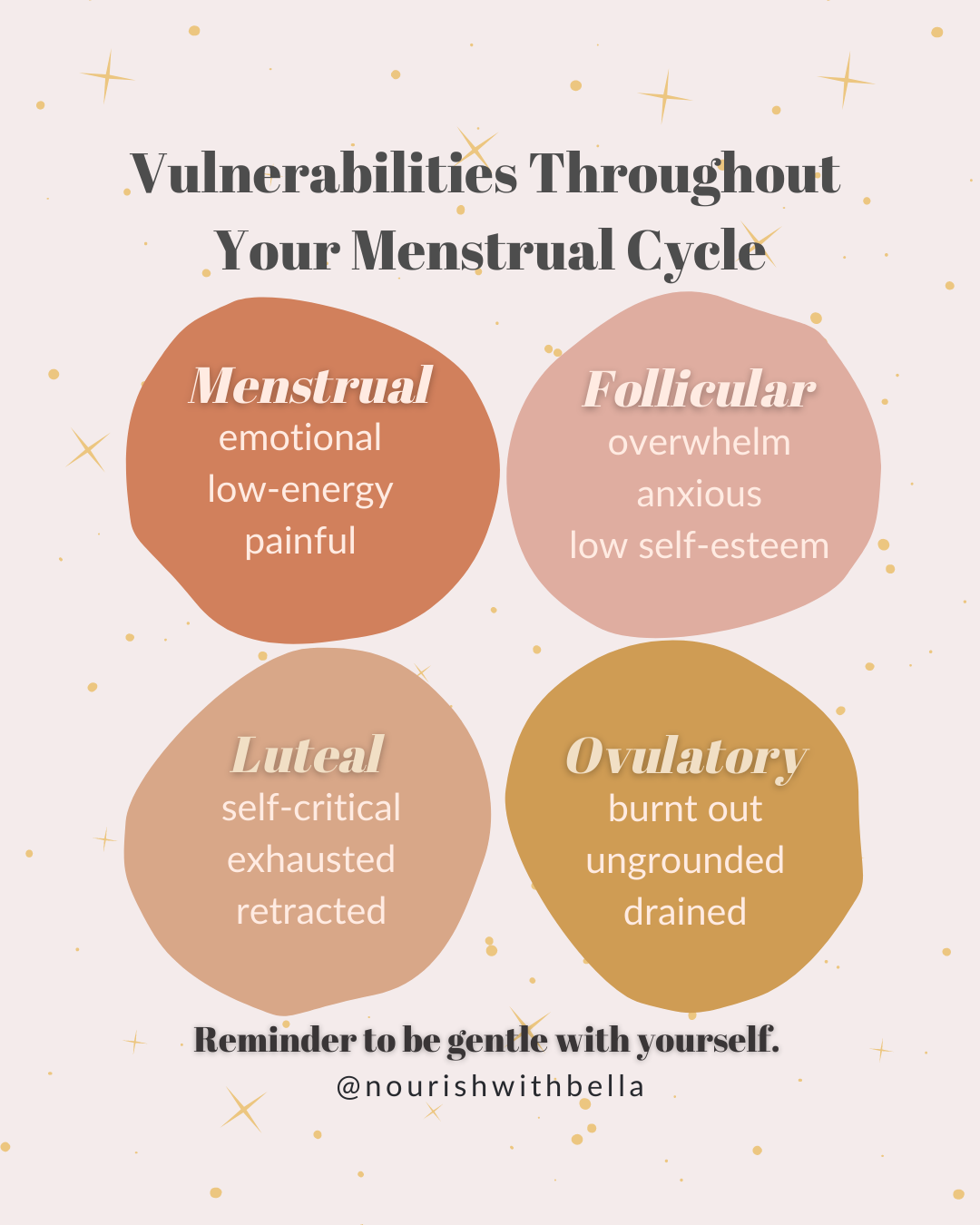How to Optimize Your Life with Your Cycle
Have you noticed that some weeks you're on top of your game, feeling confident and energized, but the next you're feeling tired and hungry with low self esteem? Women have a reason for these fluctuations.
When we typically think of the menstrual cycle, we usually just think of our period that comes once a month, but the truth is there’s so much more to each week of our cycle beyond the week we bleed.
Our hormones change from week to week causing shifts in our bodies physically, mentally, and emotionally.
As women, we are cyclical beings and follow not only the daily 24-hour circadian rhythm, rhyming with wake-sleep cycles, but also a 28-day infradian rhythm, naturally governed by a woman’s monthly hormonal cycle. A circadian rhythm is what regulates the sleep-wake cycle for all living things on earth roughly every 24 hours. For men their hormone cycle is within this 24 hour period with testosterone being high in the morning and low in the evening. Infradian cycles are cycles that last longer than 24 hours. Some examples of infradian cycles are migration, hibernation, seasonal rhythms and of course the 28-day menstrual cycle. During this 28 day cycle women's hormones fluctuate day to day.
Our current culture exists based on the 24-hour day and typically neglects the natural shift in a women’s 28 day cycle. We are often expected to keep going, keep pushing, keep creating, and keep doing until our health gives out and we fall apart. Yet we still overcommit, over extend ourselves and our expectation weighing down on our bodies and mind.
What is the result of this overcommitment?
Physical deterioration. We start to develop symptoms like heavy, irregular, painful periods, infertility, low sex drive, or more extreme symptoms like polycystic ovarian syndrome (PCOS), fibroids (abnormal growths inside the uterus), or endometriosis (tissue growth outside the uterus). Do you struggle with any of these? Keep reading.
Why are all of these symptoms on the rise? Because women are never clearly taught about their body cycles, and we often tune out what our bodies are telling us, we often ignore or don't understand our circadian and infradian cycles until something goes wrong.
A better, more healthful way to start cycle syncing (R).
How do you cycle sync (R)?
The term cycle syncing (R) was coined by Alissa Vitti founder of Flo Living. It’s all about aligning almost every aspect of your life to your body's natural biological infradian rhythms. Let’s learn how to blend our nutrition, workouts, and productivity into perfect synchronicity, improving every sector of our lives.
What are the benefits?
Here are just a few. Building energy not draining it. Feeling more confident in who you are. Feeling more comfortable in your body. Feeling less stress while getting more accomplished. Feeling more enjoyment in work. Releasing the pressure to be perfect. Feeling aligned with the process of creation. Understanding the signals of why you feel how you feel. If we live in line with our cycles, we can have better periods, more energy, better relationships, more productivity, and a greater life. I want you to find joy in your cycle and use it to your advantage and no longer fight against it.
Before we dive into the details of how to align our nutrition, movement, and productivity to our cycles, we first need to understand how our cycles work.
Hormonal Changes in the Four Phases
There are four major phases of each infaridan cycle: menstrual, follicular, ovulatory, and luteal. There are two main hormones that fluctuate throughout your cycle: estrogen and progesterone. These hormones affect your appetite, energy levels, sex drive, productivity, and more. When you intentionally support your four phases of your cycle, life becomes easier and more understandable.
Menstrual
The first phase of your cycle is menstruation. The first day you bleed is day 1. Both your primary sex hormones estrogen and progesterone are at their lowest levels. Your body is shedding its uterine lining. The first few days your energy is typically low as your body is focused on releasing, but towards the end of menstruation, you may feel your energy start to increase. The menstrual phase occurs on cycle days 1 to 6.
Follicular
As your period comes to an end, you enter your follicular phase. The pituitary gland produces a hormone called follicle stimulating hormone (FSH), telling your ovaries to prepare an egg. One of your follicles, a fluid sac containing eggs, becomes dominant and largest in preparation for ovulation. That dominant follicle produces estrogen, which increases as it grows. Your uterus responds to that rise in estrogen by thickening or rebuilding the uterine lining in preparation for a potential pregnancy. With the rise in estrogen, you may feel creative and inspired to take action after the low energy felt during your period. This phase is approximately cycle days 6 to 12 days, depending on your cycle.
Ovulatory
Ovulation is the whole goal of your menstrual cycle, if you don't ovulate you will never experience any of the three other phases. During the ovulatory phase, your estrogen is at its peak, and once levels are high enough, your brain gets the signal to release a dramatic increase in luteinizing hormone (LH), which causes the release of the egg into the fallopian tube. The egg implants to your uterus and can be fertilized for the next 24 hours. With estrogen at its peak along with a spike in testosterone, you may feel like a superwoman, energized, motivated, and ready to get it on. The ovulation phase usually lasts between cycle days 12 to 19 but may vary by person or by cycle.
Luteal
After ovulation comes the luteal phase. Your estrogen drop, signalling for the follicle containing the egg to transform into a hormone gland called the corpus luteum. This gland is what produces progesterone. Progesterone signals your uterine lining to stop thickening and start preparing for potential pregnancy. When this hormone is supported, it can make us feel calm, wanting to retreat from the world and focus on personal creativity and paying extra attention to details in life. This phase usually gets a bad rap if you experience mood swings, headaches, acne, bloating, breast tenderness, or any other effects of post menstrual syndrome (PMS). If the egg does not become fertilized, the corpus luteum breaks down, resulting in a drop in estrogen and progesterone leading to menstruation. This phase is approximately cycle days 19 to 28 but varies by individual.
To better understand, we can compare the different phases of our cycle to the phases of the moon. Menstruation is like a new moon, the follicular phase is as a waxing moon; ovulation is like a full moon, and the luteal phase is our waning moon. Many women actually have their cycle linked up with the moon and menstruate with the new moon, known as the white moon cycle, the time when most fertile and in the mothering phase of her life. On the other hand, the red moon cycle is when menstruation occurs during a full moon and these women are typically more interested in learning, teaching, creativity, and self-growth, rather than child rearing. Neither cycle is better than the other, but just different depending on the stage of life.
The phases of your cycle also mirror the seasons of the year. Using the season as a reference can make understanding your own cycle much easier. Menstruation is the winter phase of your cycle. Your hormones are at their lowest levels as you shed your uterine lining. Similar to how you feel on a cloudy snowy day, you may feel like you want to stay home, rest, and sip hot tea. Then you move into your follicular phase which is the spring phase of your cycle. As your estrogen rises you begin to blossom like a spring flower ready to start creating and planning for the new cycle ahead. As you head to ovulation you enter the summer phase of your cycle. When you ovulate and release an egg from one of your ovaries, you may feel like you want to socialize and fertilize that egg if you know what i mean. As you move into your luteal phase you enter the fall phase of your cycle. Progesterone is the hormone on the rise and you may feel like you want to start spending more time alone, organizing your life, and finishing off any task before reentering the winter phase of your cycle. Comparing how our four phases relate to the four seasons can make understanding and analyzing our own cycle easier to interpret.
Now that you have a better understanding of what happens hormonally and physically in each phase of our cycles, let’s dive into the details of how to support each phase with nutrition, movement, and productivity.
Foods, Nutrients, and Cooking Methods
Developing synchronicity with your cycle begins with nutritious food. Certain foods and cooking methods blend nicely with your infradian phase and help support proper hormone balance. Remember these foods are not an absolute necessity and are only used as a guide. Aim to include any of these foods in the respected phase to assist with hormone support and balance. We can also change up our cooking methods throughout the phases, as we naturally may crave more raw fresh foods in the spring phase of our cycle or warm cooked foods during the fall phase of our cycle. Lastly, the amount and timing of food you eat likely varies throughout the phases, eating less during the first half and more during the second half. These guides below are based on traditional Chinese medicine as well as just eating with the seasons.
Exercises
Women are largely underrepresented in sports nutrition and research. More research certainly needs to be done, but some studies show women typically have more endurance in the follicular phase and naturally burn more calories in the luteal phase. This indicates we should focus on cardio during the first half and strength training during the second. During our menstrual phase, our body already releases so much energy through bleeding that we should focus on rest and simple movements. Below is a guide on how to structure your workouts throughout your cycle.
Work and Productivity
The work and productivity aspect of living in alignment with your cycle is honestly where I personally receive the most value. I find structuring my work days based on the four phases deeply gratifying, freeing, and calibrating. In our productivity-driven society of constantly working, we must give ourselves permission to rest when menstruating and harness the abundant creative energy in the follicular phase. When we start to manage our energy instead of managing our time, we become more productive and find more joy in our work and life. Pushing too hard for too long weakens productivity and sets us up for burnout, something very common in today's society. Now, I know many of us can’t just quit life when the going gets tough entering our luteal phase, but what we can plan ahead and ask for help when we know we may need it. Below are the strengths we hold in each phase and how we can structure our time based on those strengths along with the vulnerabilities to be aware of so they do not consume you.
Syncing your nutrition, exercise, and productivity with your cycle should feel fun and a new way of living not stressful or another thing to do. You should feel joyful to establish this new relationship between you, your body, mind, and spirit.
If you’re currently struggling with any hormonal imbalances related to your cycle such as heavy, painful, or irregular periods, hormonal acne, fibroid, cyst, high stress, anxiety, or depression, low libido, gut issues, or sleep issues, make sure to check out this FREE guide. Almost all hormonal imbalances stem from being OVERSTRESSED and UNDERNOURISHED. That’s why I created this 5 Step Guide to Reduce Stress Hormones and Restore Your Nourishment. Download for free HERE!
Are you psyched about syncing? Let me know what surprised you the most from this blog post? What actions will you take to sync your life with your cycle? Tell me in the comments below.
Happy syncing!


